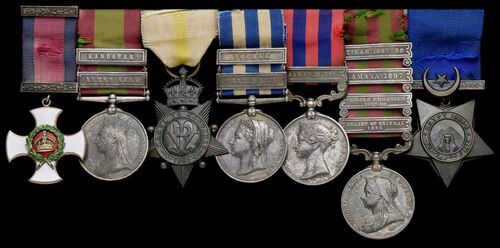
Auction: 23001 - Orders, Decorations and Medals
Lot: 212
The rare Relief of Chitral D.S.O. group of seven awarded to Colonel R. C. Hadow, 15th Sikhs, who was also severely wounded in action
Distinguished Service Order, V.R., silver-gilt and enamel; Afghanistan 1878-80, 2 clasps, Ahmed Khel, Kandahar (Lt. R. C. Hadow, 15th Ben. N.I.); Kabul to Kandahar Star 1880 (Lieut. R. C. Hadow, 15th Bengal N.I.); Egypt & Sudan 1882-89, 2 clasps, Suakin 1885, Tofrek (Captn. R. C. Hadow, 15th Sikhs.); India General Service 1854-95, 1 clasp, Samana 1891 (Major R. C. Hadow, 15th Bl. Infy.); India General Service 1895-1908, 4 clasps, Relief of Chitral 1895, Punjab Frontier 1897-98, Samana 1897, Tirah 1897-98 (Major R. C. Hadow, 15th Bl. Infy.); Khedive’s Star 1884-6, unnamed as issued, mounted on original wearing bar, ribbons now rather frayed and the Egypt Medal detached, good very fine (7)
D.S.O. London Gazette 21 January 1896 (Chitral Relief Force).
Reginald Campbell Hadow, the son of Patrick Hadow, J.P., Chairman of the P. & O. Steam Navigation Company, was born on 6 July 1851, and was educated at Cheltenham College. He was gazetted Ensign in the 55th Regiment on 27 April 1870, was promoted Lieutenant on 28 October 1871, and admitted to the Bengal Staff Corps on 26 July 1876. Appointed to the 15th Bengal Native Infantry (Ludhiana Sikhs), Hadow served throughout both campaigns of the Afghan War of 1878-80, taking part in the advance to and occupation of Kandahar, the advance from Kandahar on Ghazni and to Kabul, the march from Kabul to the relief of Kandahar, and the return to Sibi by the Hunai route, and being present at the battle of Ahmed Khel, the action of Arzu, the operations in the Logar Valley, the reconnaissance of 31 August 1880, and the battle of Kandahar (Medal & 2 clasps, Bronze Star).
He was advanced to the rank of Captain on 27 April 1882, and in February 1885 embarked for active service in the Sudan with his regiment, then styled the 15th Bengal Infantry (Loodhiana Sikhs), the word ‘Native’ having been dropped from titles on 1 January of that year. The regiment formed part of the Indian Brigade under Major-General J. Hudson, destined to act as part of the garrison at the port of Suakin under the overall command of Major-General Sir Gerald Graham. Though originally intended for defence work, Hadow and the Indian Brigade, comprising, in addition to the 15th Sikhs, the 17th Bengal Infantry, 28th Bombay Infantry, one company of 2nd Queen’s Own Sappers and Miners, and 9th Bengal Lancers, moved out from Suakin on 22 March with a Battalion each of Berkshires and Royal Marine Light Infantry, a Squadron of 5th Lancers, and a Royal Navy machine-gun detachment, towards Tamaai, which was believed to be the headquarters of the Mahdist commander Osman Digna. The Anglo-Indian force, under the command of Major-General Sir J. C. McNeill, V.C., found it hard going through the dense mimosa scrub under a scorching sun, and having covered just six miles in four hours, called a halt at Tofrek.
At 1440hrs, as the Sappers and men of the Berkshires were cutting bushes and building a zariba, the force was suddenly attacked by a screaming horde of some 5,000 ‘Fuzzy-Wuzzys’. The unfinished defences were hastily manned in the west by Hadow’s regiment, in the south by the 17th Bengalis and in the north by the 28th Bombay Infantry. Half of the Berkshires with two naval machine guns held the south-west corner, and the R.M.L.I. with two more Gardner guns the north-west corner of the position. The transport lines lay 200 yards to the east and the remainder of the Berkshires 300 yards to the north west. The enemy swept like lightening towards the half-constructed zariba from the south, driving in the cavalry pickets, scattering the transport animals and breaking the 17th Bengalis . The battle of Tofrek, or McNeill’s Zariba as it became known, had all the makings of a major disaster but fortunately the enemy, having broken into the position, charged out again on the opposite side, spurred on by the disciplined fire of the Berkshires to the north west. Some 130 British and Indian troops were killed. The butcher's bill for the other side was a thousand dead.
Thereafter the operations around Suakin fizzled out: Osman Digna’s followers lost confidence and drifted away, while Graham’s forces, unable to find them, confined their activities to burning a few huts. The war-scare caused by the Russian occupation of Panjdeh in Afghanistan provided the authorities with a convenient excuse to withdraw the bulk of the Indian Brigade. Hadow’s regiment and the 17th Bengalis, however, remained to garrison Suakin until November when they too returned to India (Medal & two clasps, Bronze Star).
Hadow became Major on 27 April 1890, and in 1891 took part with his regiment in the second Miranzai Expedition. During the Chitral Relief Expedition of 1895 he served with his regiment in the 1st Infantry Brigade, being present at the storming of the Malakand Pass and the forcing of the Swat River, receiving a mention in despatches and the D.S.O., 'in recognition of services rendered'. The insignia was presented to him on 11 April 1896 and he was promoted Lieutenant-Colonel on 27 April 1896. In 1897-98 he took part in the operations on the Samana and in the Kurram Valley Flying Column, under Colonel Richardson. He served in the Tirah campaign, being present at Chagru Kotal and Dargai, and operations in the Khanki Valley. Hadow was severely wounded by a gun shot to his right leg at Khangarbur on 26 October 1897 (Medal & 4 clasps). On 15 February 1902, he was given the Brevet rank of Colonel and, on 27 April 1902, retired with the rank of Colonel. Hadow died on 10 October 1919.
Subject to 20% VAT on Buyer’s Premium. For more information please view Terms and Conditions for Buyers.
Sold for
£7,500
Starting price
£2800




